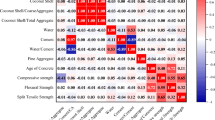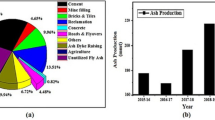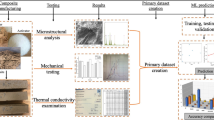Abstract
The current research delves into enhancing the sustainability of construction materials by incorporating iron waste into concrete mixtures. The primary aim revolves around predicting the compressive strength of such innovative concrete formulations, a critical factor in maintaining the structural integrity of constructions. By employing various machine learning algorithms—Support Vector Machine (SVM), Random Forest (RF), Gradient Boosting (GB), Extreme Gradient Boosting (XGB), and Multilayer Perceptron (MLP)—the study determines the most efficacious models for predicting compressive strength. Notably, Random Forest emerges as the most proficient, as evidenced by its exceptional R2 (= 0.972) and CPI score (= 0.250). A meticulous sensitivity analysis further elucidates the principal factors influencing compressive strength, notably the incorporation ratios of Iron Waste and Fine Aggregate, alongside the concrete’s age. This investigation meticulously navigates from data preprocessing to the final model selection and sensitivity analysis, ensuring the robustness of the predictive models. Moreover, the study extends its utility beyond academic realms by develo** an accessible graphical user interface (GUI), hosted on GitHub, to facilitate the application of these findings. The inclusion of iron waste not only propels the construction industry towards more sustainable practices but also valorizes waste materials. Consequently, this research contributes substantially to the domain of sustainable construction by providing a reliable methodology for the integration of iron waste in concrete, thereby fostering the development of eco-friendlier construction practices. The additional creation of a GUI significantly amplifies the impact of this research, making its insights accessible to a broader audience, thus benefiting the society and construction industry at large.

























Similar content being viewed by others
Data availability
The data that support the findings of this study are available upon reasonable request from the authors.
Abbreviations
- SVM:
-
Support vector machine
- RF:
-
Random forest
- GB:
-
Gradient boosting
- XGB:
-
Extreme gradient boosting
- MLP:
-
Multi-layer perceptron (backpropagation NN)
- PSO:
-
Particle swarm optimization
- R2 :
-
R-squared
- RMSE:
-
Root mean squared error
- MAE:
-
Mean absolute error
- MAPE:
-
Mean absolute percentage error
- CPI:
-
Comprehensive performance index
- GUI:
-
Graphical user interface
- ML:
-
Machine learning
- CNN:
-
Convolutional neural network
- BFS:
-
Blast furnace slag
- FA:
-
Fly ash
- GSA:
-
Global sensitivity analysis
References
Ben Seghier, M. E. A., Golafshani, E. M., Jafari-Asl, J., & Arashpour, M. (2023). Metaheuristic-based machine learning modeling of the compressive strength of concrete containing waste glass. Structural Concrete, 24(4), 5417–5440. https://doi.org/10.1002/SUCO.202200260
Berrar, D. (2018). Cross-validation. Encyclopedia of bioinformatics and computational biology: ABC of bioinformatics (Vol. 1–3, pp. 542–545). Academic Press.
Breiman, L. (2001). Random forests. Machine Learning, 45(1), 5–32. https://doi.org/10.1023/A:1010933404324
Chen, T., & Guestrin, C. (2016). XGBoost: A scalable tree boosting system. In Proceedings of the ACM SIGKDD international conference on knowledge discovery and data mining, 13–17 August 2016 (pp. 785–794). https://doi.org/10.1145/2939672.2939785
Cortes, C., & Vapnik, V. (1995). Support-vector networks. Machine Learning, 20(3), 273–297. https://doi.org/10.1007/bf00994018
Fan, W., Chen, Y., Li, J., Sun, Y., Feng, J., Hassanin, H., & Sareh, P. (2021). Machine learning applied to the design and inspection of reinforced concrete bridges: Resilient methods and emerging applications. Structures, 33, 3954–3963. https://doi.org/10.1016/J.ISTRUC.2021.06.110
Friedman, J. H. (2001). Greedy function approximation: A gradient boosting machine. Annals of Statistics, 29(5), 1189–1232.
Ghosh, A., & Ransinchung, G. D. (2022). Application of machine learning algorithm to assess the efficacy of varying industrial wastes and curing methods on strength development of geopolymer concrete. Construction and Building Materials, 341, 127828. https://doi.org/10.1016/J.CONBUILDMAT.2022.127828
Gu, X., **, X., & Zhou, Y. (2016). Basic principles of concrete structures. Berlin: Springer.
Hameed, M. M., Abed, M. A., Al-Ansari, N., & Alomar, M. K. (2022). Predicting compressive strength of concrete containing industrial waste materials: Novel and hybrid machine learning model. Advances in Civil Engineering. https://doi.org/10.1155/2022/5586737
Han, B., Wu, Y., & Liu, L. (2022). Prediction and uncertainty quantification of compressive strength of high-strength concrete using optimized machine learning algorithms. Structural Concrete, 23(6), 3772–3785. https://doi.org/10.1002/SUCO.202100732
Hopfield, J. (1988). Artificial neural networks. IEEE Circuits and Devices Magazine, 4(5), 3–10. https://doi.org/10.1016/B978-0-444-53632-7.01101-1
Hossain, M. U., Ng, S. T., Antwi-Afari, P., & Amor, B. (2020). Circular economy and the construction industry: Existing trends, challenges and prospective framework for sustainable construction. Renewable and Sustainable Energy Reviews, 130, 109948. https://doi.org/10.1016/J.RSER.2020.109948
Iooss, B., & Lemaître, P. (2015). A review on global sensitivity analysis methods. Operations Research/Computer Science Interfaces Series, 59, 101–122. https://doi.org/10.1007/978-1-4899-7547-8_5/COVER
Iranmanesh, A., & Kaveh, A. (1999). Structural optimization by gradient-based neural networks. International Journal for Numerical Methods in Engineering, 46(2), 297–311.
Ismail, Z. Z., & AL-Hashmi, E. A. (2008). Reuse of waste iron as a partial replacement of sand in concrete. Waste Management, 28(11), 2048–2053. https://doi.org/10.1016/J.WASMAN.2007.07.009
Kaveh, A., Elmieh, R., & Servati, H. (2001). Prediction of moment-rotation characteristic for semi-rigid connections using BP neural networks 131–142.
Kaveh, A., Eskandari, A., & Movasat, M. (2023). Buckling resistance prediction of high-strength steel columns using metaheuristic-trained artificial neural networks. Structures, 56, 104853.
Kennedy, J., & Eberhart, R. (1995). Particle Swarm Optimization. Proceedings of ICNN’95 International Conference on Neural Networks, 4, 1942–1948. https://doi.org/10.1002/9780470612163
Khan, K., & Su, C. W. (2021). Urbanization and carbon emissions: A panel threshold analysis. Environmental Science and Pollution Research, 28(20), 26073–26081. https://doi.org/10.1007/S11356-021-12443-6/METRICS
Khan, S. A., Koç, M., & Al-Ghamdi, S. G. (2021). Sustainability assessment, potentials and challenges of 3D printed concrete structures: A systematic review for built environmental applications. Journal of Cleaner Production, 303, 127027. https://doi.org/10.1016/J.JCLEPRO.2021.127027
Kirthika, S. K., Singh, S. K., & Chourasia, A. (2020). Alternative fine aggregates in production of sustainable concrete—A review. Journal of Cleaner Production, 268, 122089. https://doi.org/10.1016/J.JCLEPRO.2020.122089
Krikar, M., & Gharrib Noori, H. H. I. (2018). Mechanical Properties of Concrete Using Iron Waste as a Partial Replacement of Sand. Proceedings of the Fourth International Conference Engineering on Developments in Civil and Computer Engineering Applications, 3(3), 26–27. https://doi.org/10.3918/eajse.v3i3p75
Lundh, F. (1999). An introduction to tkinter. www.pythonware.com/library/tkinter/introduction/index.htm.
Lv, Z., Jiang, A., & Liang, B. (2022). Development of eco-efficiency concrete containing diatomite and iron ore tailings: Mechanical properties and strength prediction using deep learning. Construction and Building Materials, 327, 126930. https://doi.org/10.1016/J.CONBUILDMAT.2022.126930
Mahmoudian, A., Tajik, N., Taleshi, M. M., Shakiba, M., & Yekrangnia, M. (2023). Ensemble machine learning-based approach with genetic algorithm optimization for predicting bond strength and failure mode in concrete-GFRP mat anchorage interface. Structures, 57, 105173. https://doi.org/10.1016/J.ISTRUC.2023.105173
Meier, H., Roy, R., & Seliger, G. (2010). Industrial product-service systems—IPS2. CIRP Annals, 59(2), 607–627. https://doi.org/10.1016/J.CIRP.2010.05.004
Mohammed Breesem, K., Jasim Mohammed, T., Raheem Hassen, D., & Mohammed Heil, S. (2023). Properties of concrete using waste iron. Materials Today: Proceedings, 80, 769–773. https://doi.org/10.1016/J.MATPR.2022.11.084
Nguyen, X. H., Phan, Q. M., Nguyen, N. T., & Tran, V. Q. (2023). Interpretable machine learning model for evaluating mechanical properties of concrete made with recycled concrete aggregate. Structural Concrete. https://doi.org/10.1002/SUCO.202300614
Nguyen-Sy, T., Thai, M. Q., & Vu, M. N. (2023). Optimized machine-learning methods for predicting the long-term viscoelastic behavior of heterogeneous concrete mixtures. Structural Concrete, 24(6), 7466–7481. https://doi.org/10.1002/SUCO.202300246
Patel, S., & Sobh, T. (2015). Manipulator performance measures—A comprehensive literature survey. Journal of Intelligent and Robotic Systems: Theory and Applications, 77(3–4), 547–570. https://doi.org/10.1007/S10846-014-0024-Y/METRICS
Pearson, K. (1920). Notes on the history of correlation. Biometrika, 13(1), 45. https://doi.org/10.2307/2331722
Qi, C., Huang, B., Wu, M., Wang, K., Yang, S., & Li, G. (2022). Concrete strength prediction using different machine learning processes: effect of slag, fly ash and superplasticizer. Materials, 15(15), 5369. https://doi.org/10.3390/MA15155369
Radlinski, M., Harris, N. J., & Moncarz, P. D. (2011). Sustainable concrete: Impacts of existing and emerging materials and technologies on the construction industry. In AEI 2011: Building integrated solutions—proceedings of the AEI 2011 conference (pp. 252–262). https://doi.org/10.1061/41168(399)31
Rofooei, F. R., Kaveh, A., & Farahani, F. M. (2011). Estimating the vulnerability of the concrete moment resisting frame structures using artificial neural networks. International Journal of Optimization in Civil Engineering, 1(3), 433–448.
Sahu, A., Kumar, S., Srivastava, A. K. L., & Pratap, B. (2023). Machine learning approach to study the mechanical properties of recycled aggregate concrete using copper slag at elevated temperature. Asian Journal of Civil Engineering, 25(1), 911–921. https://doi.org/10.1007/S42107-023-00821-Z/METRICS
Sandeep, M. S., Tiprak, K., Kaewunruen, S., Pheinsusom, P., & Pansuk, W. (2023). Shear strength prediction of reinforced concrete beams using machine learning. Structures, 47, 1196–1211. https://doi.org/10.1016/J.ISTRUC.2022.11.140
Santhosh, K. G., Subhani, S. M., & Bahurudeen, A. (2021). Cleaner production of concrete by using industrial by-products as fine aggregate: A sustainable solution to excessive river sand mining. Journal of Building Engineering, 42, 102415. https://doi.org/10.1016/J.JOBE.2021.102415
Scrivener, K. L., John, V. M., & Gartner, E. M. (2018). Eco-efficient cements: Potential economically viable solutions for a low-CO2 cement-based materials industry. Cement and Concrete Research, 114, 2–26. https://doi.org/10.1016/J.CEMCONRES.2018.03.015
Srivastava, A., & Singh, S. K. (2020). Utilization of alternative sand for preparation of sustainable mortar: A review. Journal of Cleaner Production, 253, 119706. https://doi.org/10.1016/J.JCLEPRO.2019.119706
Tiegoum Wembe, J., Mambou Ngueyep, L. L., Elat Assoua Moukete, E., Eslami, J., Pliya, P., Ndjaka, J. M. B., & Noumowe, A. (2023). Physical, mechanical properties and microstructure of concretes made with natural and crushed aggregates: Application in building construction. Cleaner Materials, 7, 100173. https://doi.org/10.1016/J.CLEMA.2023.100173
Tipu, R. K., Batra, V., Suman, Panchal, V. R., & Pandya, K. S. (2023a). Predictive modelling of surface chloride concentration in marine concrete structures: A comparative analysis of machine learning approaches. Asian Journal of Civil Engineering. https://doi.org/10.1007/S42107-023-00854-4/METRICS
Tipu, R. K., Panchal, V. R., & Pandya, K. S. (2023b). Enhancing chloride concentration prediction in marine concrete using conjugate gradient-optimized backpropagation neural network. Asian Journal of Civil Engineering, 1, 637–656.
Tipu, R. K., Suman, & Batra, V. (2023c). Development of a hybrid stacked machine learning model for predicting compressive strength of high-performance concrete. Asian Journal of Civil Engineering, 24(8), 2985–3000.
van Vuuren, D. P., Stehfest, E., Gernaat, D. E. H. J., Doelman, J. C., van den Berg, M., Harmsen, M., de Boer, H. S., Bouwman, L. F., Daioglou, V., Edelenbosch, O. Y., Girod, B., Kram, T., Lassaletta, L., Lucas, P. L., van Meijl, H., Müller, C., van Ruijven, B. J., van der Sluis, S., & Tabeau, A. (2017). Energy, land-use and greenhouse gas emissions trajectories under a green growth paradigm. Global Environmental Change, 42, 237–250. https://doi.org/10.1016/J.GLOENVCHA.2016.05.008
**ao, L., Li, Q. Y., Li, H., & Ren, Q. (2022). Loading capacity prediction and optimization of cold-formed steel built-up section columns based on machine learning methods. Thin-Walled Structures, 180, 109826. https://doi.org/10.1016/J.TWS.2022.109826
Yavartanoo, F., & Kang, T. H. K. (2022). Retrofitting of unreinforced masonry structures and considerations for heritage-sensitive constructions. Journal of Building Engineering, 49, 103993. https://doi.org/10.1016/J.JOBE.2022.103993
Zar, J. H. (2005). Spearman rank correlation. Encyclopedia of Biostatistics. https://doi.org/10.1002/0470011815.B2A15150
Funding
The authors have not disclosed any funding.
Author information
Authors and Affiliations
Contributions
RKT played a pivotal role in the genesis and execution of this research. His contributions spanned the original writing of the manuscript, formulating the underlying idea, devising the methodology, executing the coding, analyzing the results, and generating the plots. His work laid the foundation for the study and shaped its direction. V. B. , Suman, V. R. Panchal, K. S. Pandya, and G. A. Patel provided significant contributions through a rigorous review and revision process. Their expertise was instrumental in refining the manuscript to meet high academic standards. Additionally, they played a crucial role in the data collection process, ensuring the study was grounded in comprehensive and relevant data. Collectively, their efforts have been vital in enhancing the quality and depth of the research, contributing to its overall success.
Corresponding author
Ethics declarations
Conflict of interest
The authors declare that they have no known competing financial interests or personal relationships that could have appeared to influence the work reported in this paper.
Additional information
Publisher's Note
Springer Nature remains neutral with regard to jurisdictional claims in published maps and institutional affiliations.
Rights and permissions
Springer Nature or its licensor (e.g. a society or other partner) holds exclusive rights to this article under a publishing agreement with the author(s) or other rightsholder(s); author self-archiving of the accepted manuscript version of this article is solely governed by the terms of such publishing agreement and applicable law.
About this article
Cite this article
Tipu, R.K., Batra, V., Suman et al. Optimizing compressive strength in sustainable concrete: a machine learning approach with iron waste integration. Asian J Civ Eng (2024). https://doi.org/10.1007/s42107-024-01061-5
Received:
Accepted:
Published:
DOI: https://doi.org/10.1007/s42107-024-01061-5




